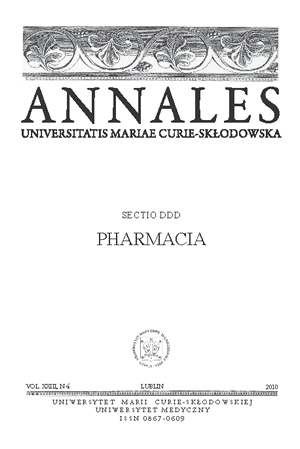Związki fenolowe w kwitnącym zielu Cirsium esculentum (Siev.) C. A. Mey
Słowa kluczowe:
ASE, flawonoidy, kwas chlorogenowy, Cirsium esculentum (Siev.) C. A. Mey.Abstrakt
W pracy omówiono analizę jakościową i ilościową zidentyfikowanych substancji aktywnych uzyskanych z nadziemnych kwitnących części Cirsium esculentum (Siev.) C. A. Mey. W celu identyfikacji kwasów fenolowych i flawonoidów w kwitnącym zielu Cirsium esculentum (Siev.) C. A. przeprowadzono ekstrakcję przy użyciu ASE oraz jakościową i ilościową analizę TLC oraz SPE-HPLC badanych związków. Zebrano i porównano widma z dostępnymi wzorcami. Przeprowadzona kalibracja dla kwasów fenolowych i flawonoidów jest wysoce linearna (R2 > 0.991) w stężeniu 0.05–1.00 mg na 10 mL (n = 3). W wyniku przeprowadzonych badań w zielu stwierdzono obecność kwasu chlorogenowego oraz flawonoidów: 3 ramnoglukozyd kemferolu (6437.51 μg/g) i rutozydu (1184.85 μg/g). Otrzymany wyciąg jest bogaty w związki flawonoidowe, które zostały niezidentyfikowane, dlatego też będą prowadzone dalsze badania. Badania składu jakościowego i ilościowego nadziemnych części Cirsium esculentum (Siev.) C. A. Mey. były przeprowadzone po raz pierwszy.
Bibliografia
1. Abrahao S.A., Pereira R.G., Duarte S.M. at al.: Coffee (Coffea arabica L.) bioactive compounds and antioxidant activity, Ciencia e Agrotecnologia, 34 , 2, 414, 2010.
2. Alvarez-Suarez J.M., Tulipani S., Romandini S. at al.: Methodological Aspects about Determination of Phenolic Compounds and In Vitro Evaluation of Antioxidant Capacity in the Honey, Current Analytical Chemistry, 5, 293, 293, 2009.
3. Beretz A., Cazenave J.: The effect of flavonoids on blood vessel wall interactions. In: Cody V., Middleton E., Harborne J.B. and Beretz A. (eds.) Plant Flavonoids in Biology and Medicine II: Biochemical, Cellular and Medicinal Properties. Alan R. Liss, 187, New York 1988.
4. Chao-Yang M., Jinan T., Hong-Xin W. at al.: Simulationes determination of six active compounds in Rhodiola L. by RP-LC, Chromatographia, 67, 383, 2008.
5. Fathiazada F., Delazara A., Amiria R., Sarkerb S.D.: Extraction of Flavonoids and Quantification of Rutin from waste Tobacco Leaves, Iranian J of Pharmaceut. Res, 3, 222, 2006.
6. Gleńsk M., Sawicka U., Mażol I., Cisowski W.: 2D TLC-graft planar chromatography in the analysis of a mixture of phenolic acids, J. Planar Chromatogr., 15, 463-465, 2002.
7. Grinberg L.N., Rachmilewitz E.A., Newmark H.: Protective effects of rutin against hemoglobin oxidation, Biochem. Pharmacol., 48, 643, 1994.
8. Harborne J.B.: The Biology and Chemistry of the Compositae, Academic Press, UK, 359, London 1998.
9. Iwashina T., Kadota Y., Ueno T., Ootani S.: Foliar flavonoid composition in Japanese Cirsium species (Compositae), and their chemotaxonomic significance, J. Jap. Bot., 70, 280,1995.
10. Jordon-Thaden I.E., Louda S.M.: Chemistry of Cirsium and Carduus: a role in ecological risk assessment for biological control of weeds? Biochem. System Ecol., 31, 1353, 2003.
11. Krzaczek T., Sokołowska-Woźniak A., Smolarz H.D.: Phenolic compounds of Cirsium rivulare (Jacq.) All. Annales UMCS, Lublin, sect. DDD, 3, 51, 1990.
12. Kun W., Lin-Hong Y., Wei X.: Inhibitory effects of apigenin on the growth of gastric carcinoma SGC-7901 cells. World J. Gastroenterol., 11, 29, 4461, 2005.
13. Mabry T.J., Markham K.R., Thomas M.B.: The Systematic Identification of flavonoids, Springer–Verlag, New York 1970.
14. Matysik G., Wójciak-Kosior M.: Optimized method for the determination of flavonoid glycosides and aglycones, Chromatographia, 61, 89, 2005.
15. Nakatani N., Kayano S., Kikuzaki H. at al: Identification, quantitative determination, and antioxidative activities of chlorogenic acid isomers in prune (Prunus domestica L.), J. Agric. Food Chem., 48, 11, 5512, 2000.
16. Nazaruk J., Brzóska T.: Current state of the knowledge about the pharmacological activity of plants from Cirsium Mill. Genus.
Postępy Fitoterapii, 3, 170, 2008.
17. Nazaruk J., Gudej J.: Flavonoid compounds from the flowers of Cirsium rivulare (Jacq.) All. Acta Poloniae Pharmaceutica, 60, 87, 2003.
18. Nazaruk J.: Antioxidant activity and total phenols content in Cirsium five species from north-east region of Poland. Phytotherapy, 79, 3, 194, 2008.
19. Nazaruk J., Jakoniuk P.: Flavonoid composition and antimicrobial activity of Cirsium rivulare (Jacq.) All. Flowers J. Ethnopharmacol, 102, 2, 208, 2005.
20. Nazaruk J., Szoka Ł.: The qualitative and quantitative analysis of phenolic acids and flavonoids in Cirsium spp., Herba Polonica, 55, 4, 32, 2009.
21. Niggeweg R., Michael A.J., Cathie M.: Engineering plants with increased levels of the antioxidant chlorogenic acid. Nat. Biotech., 22, 746, 2004.
22. Robards K., Antolovich M.: Electrofocusing of Methanolic Extracts for Identification of Individual Flavonol Biomolecules in Camellia Species, Analyst., 122, 11, 1997.
23. Smolarz H.D., Waksmundzka-Hajnos M.: Two-dimentional of phenolic acids on cellulose, J.Planar Chromatogr.,6,278,1993.
24. Stalikas C.D.: Extraction, separation and detection methods for phenolic acids and flavonoids, J. Sep. Sciences, 30, 3268, 2007.
25. Waksmundzka-Hajnos M., Oniszczuk A., Szewczyk K.: Effect of sample- preparation methods on the HPLC quantitation of some phenolic acids in plant materials, Acta Chromatogr., 19, 227, 2007.
26. Xia D., Shi J., Gong J. et al: Antioxidant activity of Chinese mei (Prunus mume) and its active phytochemicals, J. Med Plants Res., 4, 12, 1156, 2010.
27. Zgórka G., Hajnos A.: The application of solid-phase extraction and reversed phase high-performance liquid chromatography for simultaneous isolation and determination of plant flavonoids and phenolic acids, Chromatographia, 57, 1, 77, 2003.
28. Zhang QL, Li J, Wang C, at al.: A gradient HPLC method for the quality control of chlorogenic acid, linarin and luteolin in Flos Chrysanthemi Indici suppository, J. Pharm. Biomed. Anal., 43, 753, 2007.
Pobrania
Opublikowane
Numer
Dział
Licencja
Prawa autorskie (c) 2010 Autorzy

Praca jest udostępniana na licencji Creative Commons Attribution-NonCommercial-NoDerivatives 3.0 Unported License.


